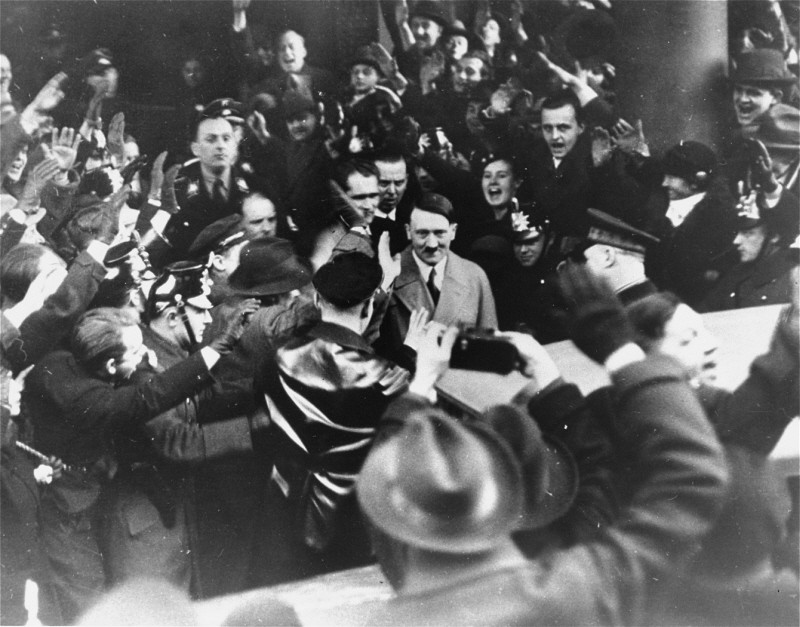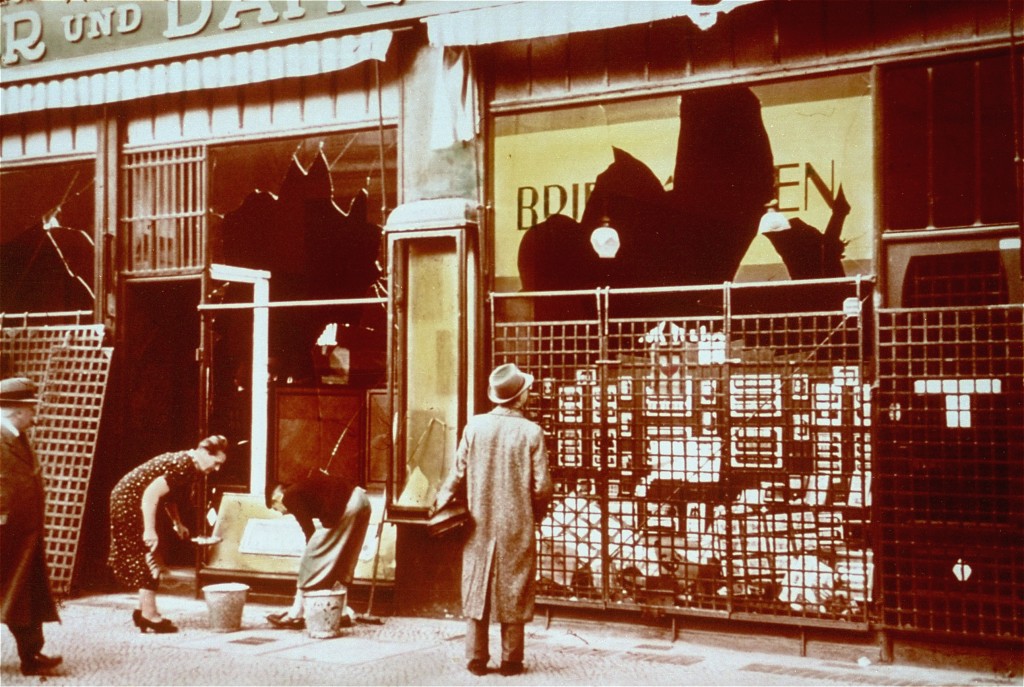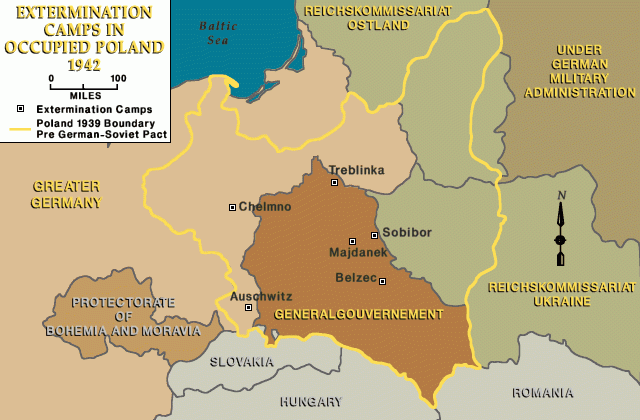
SS: Key Dates
1925
Adolf Hitler, the Führer of the Nazi party, establishes the SS (Schutzstaffel; Protection Squadrons).
January 1929
Hitler appoints Heinrich Himmler Reichsführer-SS (Reich Leader of the SS).
Summer 1931
Himmler creates the Security Service (Sicherheitsdienst-SD) of the Nazi Party.
December 1931
Himmler establishes the SS Race and Settlement Office (SS Rasse- und Siedlungsamt), which determines eligibility for entry into the SS and establishes the SS as a so-called racial elite.

January 1933
The Nazis obtain control of the German state with the appointment of Adolf Hitler as Chancellor, marking the beginning of the Third Reich.
1934
The SS establishes a department in the SD to “research” the “Jewish question.”
Summer 1934
Hitler announces that the SS is an independent organization as a reward for its role in murdering Ernst Röhm and the top leadership of the SA.
Summer 1934
Hitler authorizes Himmler to centralize the concentration camp system under SS leadership.
August 1934
Nazi party Deputy Führer Rudolf Hess grants the SD sole authorization to gather political intelligence in the Third Reich.
Late 1934
Himmler and Reinhard Heydrich centralize the regional German political police departments within the Secret State Police (Geheime Staatspolizei-Gestapo).
December 1935
The SS establishes the Lebensborn (Fount of Life) Society, which is to care for children born out of wedlock to women whom the SS deems racially suitable.
Summer 1936
Adolf Hitler appoints Himmler as Reichsführer SS and Chief of German Police. Himmler is now commander of all German police. Himmler completes the centralization of the various criminal police departments in Germany into the Reich Criminal Police Office (Reichskriminalpolizeiamt). Himmler appoints Heydrich chief of the Security Police Main Office (Hauptamt Sicherheitspolizei); this office includes both Gestapo and Criminal Police. Himmler also centralizes the uniformed police forces, known as the Order Police (Ordnungspolizei-Orpo) into the Order Police Main Office (Hauptamt Ordnungspolizei) under SS General Kurt Daluege.
1937
The SS takes control of the Ethnic German Liaison Office (Volksdeutsche Mittelstelle-VoMi).
1938
The SD creates a station in Vienna (Zentralstelle für jüdische Auswanderung) to facilitate the forced emigration of Jews from Austria.

November 9–10, 1938
The SS and police help carry out the violence of Kristallnacht (often referred to in English as the “Night of Broken Glass”). During the anti-Jewish riot, the German police arrest some 30,000 Jews and incarcerate about 26,000 of them in concentration camps.
January 24, 1939
Hermann Göring authorizes Security Police and SD chief Heydrich to develop plans for a “solution to the Jewish Question” in the Third Reich.
September 1, 1939
Germany invades Poland, starting World War II.
September 27, 1939
Himmler fuses the Security Police and the SD into the Reich Security Main Office (Reichssicherheitshauptamt-RSHA), which will later be tasked with implementing the Holocaust.
October 7, 1939
Hitler appoints Himmler Reich Commissar for the Strengthening of German Ethnic Stock (Reichskommissar für die Festigung deutschen Volkstums-RKFDV). This appointment gives Himmler leading authority to plan and implement population policy in German-occupied Poland.
Late 1939
Himmler establishes the Waffen SS, an armed SS force.
June 22, 1941
Nazi Germany invades the Soviet Union. SS and police authorities supported by the military and by local auxiliaries begin to systematically shoot Soviet Jews.
July 17, 1941
Hitler extends Himmler's authority for security and settlement operations to the occupied Soviet Union. The SS has exclusive responsibility for security behind the front lines in the Soviet Union.
July 31, 1941
Göring authorizes Heydrich, chief of the RSHA, to coordinate the resources of the Reich for a “solution” to the “Jewish Question.”

December 1941-Summer 1942
As the elimination of Jewish communities in the Soviet Union continues by means of shooting, the SS constructs and puts into operation five killing centers in German-occupied Poland to annihilate the European Jews.
January 20, 1942
RSHA chief Heydrich convenes the Wannsee Conference, presenting his plans to coordinate a European-wide “Final Solution of the Jewish Question” to key officials from Reich ministries. He informs them that Hitler had authorized the operation and had designated the SS to coordinate “Final Solution” policy.
March 1942
Himmler incorporates the Inspectorate of Concentration Camps with the SS Economic-Administration Main Office (SS-Wirtschafts-Verwaltungshauptamt-WVHA) under SS General Oswald Pohl.
1945
The SS begin to disintegrate as German defeat becomes imminent.
April 28-29, 1945
Himmler attempts to transmit an offer of surrender to the commander-in-chief of the Allied forces. When Hitler hears of the attempt, he strips Himmler of all his offices and orders his arrest.
May 20, 1945
Soviet troops capture Himmler at a checkpoint near Bremervoerde, Germany and turn him over to British authorities.
May 23, 1945
Himmler commits suicide in British custody.
November 1945-October 1946
The Trial of the Major War Criminals is held in Nuremberg under the auspices of the International Military Tribunal (IMT). To represent the SS and its crimes on the defendant's dock, tribunal prosecutors select former SS General Ernst Kaltenbrunner, Heydrich's successor as chief of the RSHA. The Tribunal judges convict Kaltenbrunner and sentence him to death. They also find the SS and the Gestapo-SD to be criminal organizations.
Critical Thinking Questions
In what ways did the SS coordinate the activities of German and foreign police agencies to promote the systematic persecution and mass murder of Europe's Jews?
In what ways did the SS coordinate the activities of German and foreign police agencies to promote the systematic persecution and mass murder of Europe's Jews?
Across Europe, the Nazis found countless willing helpers who collaborated or were complicit in their crimes. What motives and pressures led so many individuals to persecute, to murder, or to abandon their fellow human beings?

